High blood pressure is extremely common, affecting approximately one in three American adults. High blood pressure can contribute to heart attack, stroke, kidney disease, and even death when not treated appropriately. Fortunately, high blood pressure can be lowered quickly through diet, exercise, and blood pressure medications. This article will review how you can lower your blood pressure without medications as well as outline some of the most commonly used high blood pressure medication. An infographic is included for quick reference.
Have questions on high blood pressure medications and how to lower blood pressure? If you don’t find them in the infographic and article below or just want more information, you can ask a pharmacist online 24/7 with Medidex Connect.
Please include attribution to medidex.chat with this image.
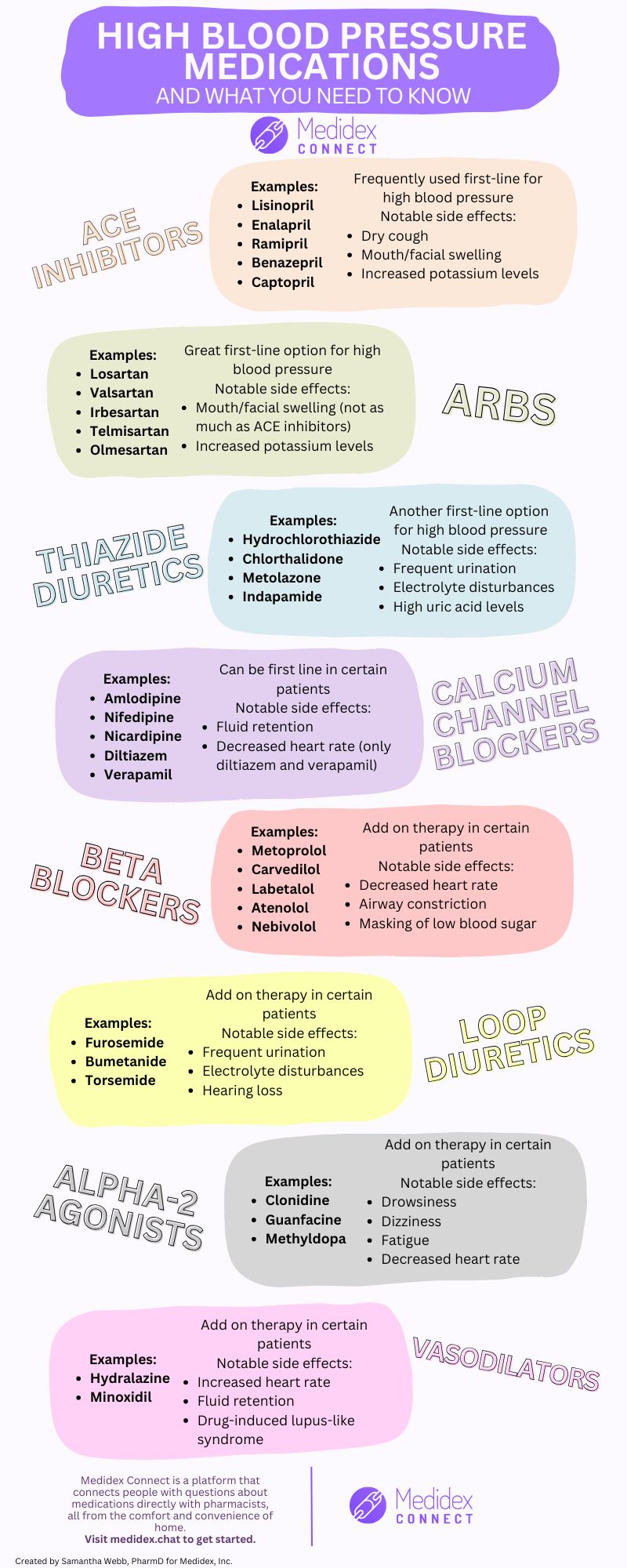
To share this image on your site:
How to Lower Blood Pressure Quickly
Blood pressure is most effectively lowered by lifestyle changes and medications.
How to Lower Blood Pressure without Medications
Depending on how high your blood pressure is, your provider may recommend you try to lower your blood pressure without medications initially. Blood pressure can be lowered quickly and effectively through things like diet changes, regular exercise, and weight loss if needed.
Diet Changes
One of the most commonly recommended diets to lower blood pressure is the DASH diet. The DASH diet is essentially eating a diet that emphasizes intake of fruits, vegetables, whole grains, and low-fat dairy products, while also reducing intake of fat. Another dietary way to lower blood pressure quickly is by reducing intake of sodium (salt). The American Heart Association recommends less than 1500 mg per day for most adults. It is also recommended to limit alcohol intake to 2 drinks or less per day for men, and one drink or less per day for women. These changes alone can lower blood pressure by up to 20 mmHg.
Exercise
Regular exercise has been proven to lower blood pressure, although works best when combined with other lifestyle changes and/or medications. A structured exercise program is recommended for adults with high blood pressure that combines aerobic and resistance training.
Weight Loss
It has been shown that for every 1 kg (2.2 lb) reduction in body weight, one can expect a roughly 1 mmHg drop in blood pressure. This is only recommended for adults who are overweight or obese.
High Blood Pressure Medications
Your provider may recommend taking high blood pressure medications if lifestyle modifications are inadequate, if you have a history of cardiovascular disease, or for prevention if you are at an increased risk of cardiovascular events like heart attack or stroke. Some common blood pressure medication names and details are reviewed below.
ACE Inhibitors
Angiotensin-converting enzyme (ACE) inhibitors are very effective and frequently used first-line for treatment of high blood pressure, especially if a person has other medical diagnoses like heart failure or ischemic heart disease. Some common examples are:
- Lisinopril (Zestril)
- Enalapril (Vasotec)
- Ramipril (Altace)
- Benazepril (Lotensin)
- Captopril (Capoten)
Some notable side effects of ACE inhibitors include dry cough and facial/mouth swelling (also known as angioedema). Patients who have a history of angioedema or renal artery stenosis should not take ACE inhibitors. Patients with chronic kidney disease are at an increased risk of elevated potassium levels from ACE inhibitors.
ARBs
Angiotensin II receptor blockers (ARBs) are another first line class of high blood pressure medications. They work on the same biological pathway that ACE inhibitors work on, so these two medication classes should not be taken together. Some common examples are:
- Losartan (Cozaar)
- Valsartan (Diovan)
- Irbesartan (Avapro)
- Telmisartan (Micardis)
- Olmesartan (Benicar)
Similarly to ACE inhibitors, ARBs carry a risk of angioedema, however at a much lower rate. There is also the same risk of elevated potassium levels and kidney injury.
Thiazide Diuretics
Thiazide diuretics are another first line class of high blood pressure medications that work by causing the kidneys to excrete excess sodium and water. Some common examples are:
- Hydrochlorothiazide (HCTZ)
- Chlorthalidone (Thalitone)
- Metolazone (Zytanix)
- Indapamide (Natrilix)
Since thiazides are diuretics, the most common effect patients may see is excessive urination. This may also cause electrolyte disturbances and should be monitored. Thiazides should be used with caution if there is a history of gout, since thiazides can cause increased uric acid levels.
Calcium Channel Blockers
Calcium channels blockers can be considered first-line agents in certain patients. Some common examples are:
- Amlodipine (Norvasc)
- Nifedipine (Procardia)
- Nicardipine (Cardene)
- Diltiazem (Cardizem)
- Verapamil (Calan)
Calcium channel blockers should generally be avoided in patients with a history of congestive heart failure. Calcium channel blockers can cause fluid retention in the legs. Diltiazem and verapamil can also cause heart rate to decrease, and these may be a good option in patients who also have atrial fibrillation. Nifedipine is a preferred option in pregnancy.
Beta Blockers
Beta blockers are sometimes used as add-on therapy when other agents do not achieve blood pressure goals, or if a patient has certain concomitant diseases like atrial fibrillation, previous heart attack, or congestive heart failure. Some common examples are:
- Metoprolol (Toprol XL, Lopressor)
- Carvedilol (Coreg)
- Labetalol (Trandate)
- Atenolol (Tenormin)
- Nebivolol (Bystolic)
The most common effect observed with beta blockers is decreased heart rate. Patients who have a history of asthma should use caution when taking a beta blocker, as some may worsen symptoms related to airway constriction. In patients with diabetes, beta blockers can also mask the symptoms of low blood sugar, so this should be monitored carefully.
Loop Diuretics
Loop diuretics are commonly used for high blood pressure when other agents do not achieve blood pressure goals, or if a patient has a history of congestive heart failure. Examples are:
- Furosemide (Lasix)
- Bumetanide (Bumex)
- Torsemide (Demadex)
Since loop diuretics are potent diuretics, they can lead to increased urination which may be bothersome to some patients. Loop diuretics can cause electrolyte disturbances, and, rarely, may cause hearing loss at higher doses.
Alpha-2 Agonists
Alpha-2 agonists may be added on to a high blood pressure regimen if other options do not achieve blood pressure goals. Some examples are:
- Clonidine (Catapres)
- Guanfacine (Tenex)
- Methyldopa
Alpha-2 agonists differ from other medications as they work in the brain instead of working directly on the blood vessels. Because of this, these medications may cause side effects such as dizziness, drowsiness, fatigue, etc. Methyldopa is a preferred option in pregnancy.
Direct Vasodilators
Direct vasodilators are sometimes used last-line if other options are inadequate or unable to be tolerated. Examples are:
- Hydralazine (Apresoline)
- Minoxidil (Loniten)
These medications are effective at lowering blood pressure, but may cause unwanted side effects such as increased heart rate and fluid retention. Hydralazine, at high doses, may also be associated with drug-induced lupus-like syndrome. Minoxidil is more commonly used off-label to stimulate hair growth.
Conclusion
As described above, there are many different ways to lower blood pressure effectively and quickly. Healthy diet and exercise are recommended for most adults with high blood pressure, and high blood pressure medications may be recommended by your provider to further lower blood pressure if necessary.
If you have additional questions on how to lower blood pressure, medications for treating high blood pressure or just want more information on high blood pressure in general you can connect with a licensed pharmacist on-demand using Medidex Connect.
References
- Whelton PK, Carey RM, Aronow WS, et al. 2017 ACC/AHA/AAPA/ABC/ACPM/AGS/APhA/ASH/ASPC/NMA/PCNA Guideline for the Prevention, Detection, Evaluation, and Management of High Blood Pressure in Adults: A Report of the American College of Cardiology/American Heart Association Task Force on Clinical Practice Guidelines. Hypertension. 2017;71(6). doi:10.1161/hyp.0000000000000065
- Unger T, Borghi C, Charchar F, et al. 2020 International Society of Hypertension Global Hypertension Practice Guidelines. Hypertension. 2020;75(6):1334-1357. doi:10.1161/hypertensionaha.120.15026
- Lexi-Drugs. UpToDate Lexidrug. UpToDate Inc. https://online.lexi.com. Accessed October 2, 2024.
Disclaimer: This website does not provide medical advice. No content on this site is intended to be a substitute for professional medical advice, diagnosis, or treatment. All content on this site is for educational and informational purposes only, does not constitute medical advice, and does not establish any kind of patient-provider or client-professional relationship by your use of this website. Although we strive to strictly provide accurate and up to date general information, content available on this site is not a substitute for professional medical advice, and you should not rely solely on the information provided here. Always seek the advice of your physician or other qualified healthcare provider with any questions you may have regarding medical conditions, treatments, or medications.


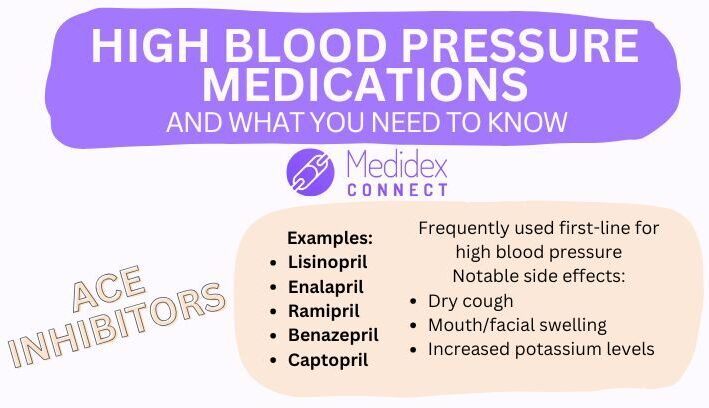

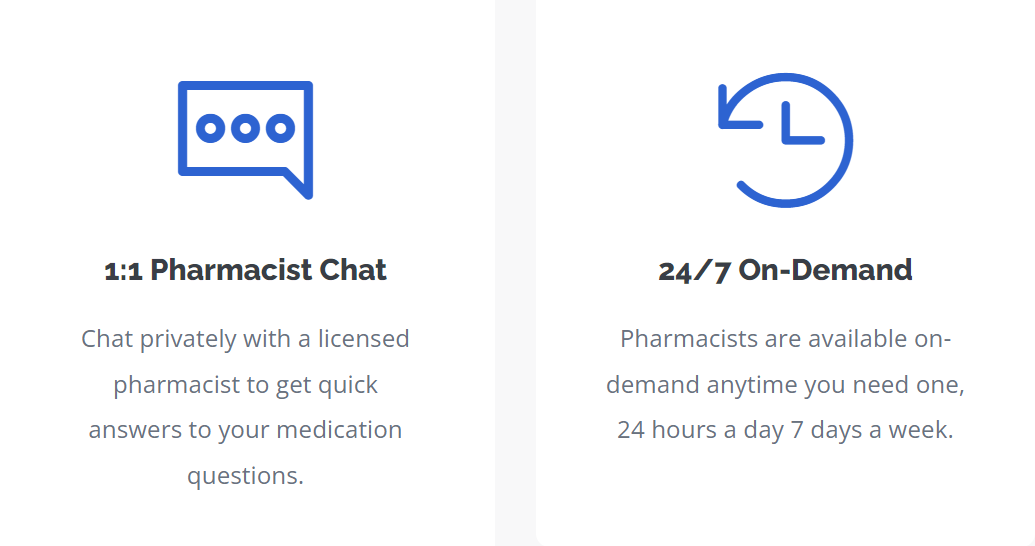
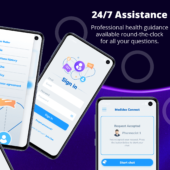
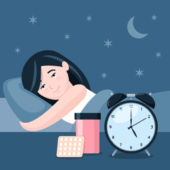
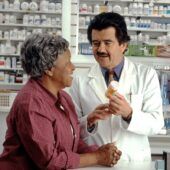
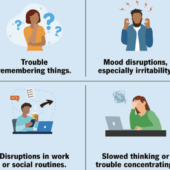
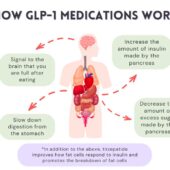
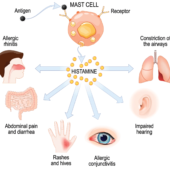
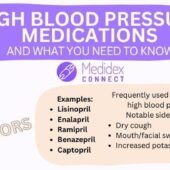
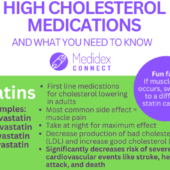
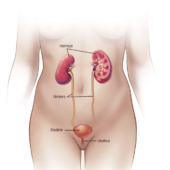
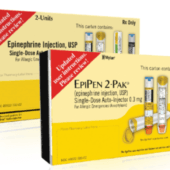
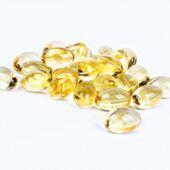


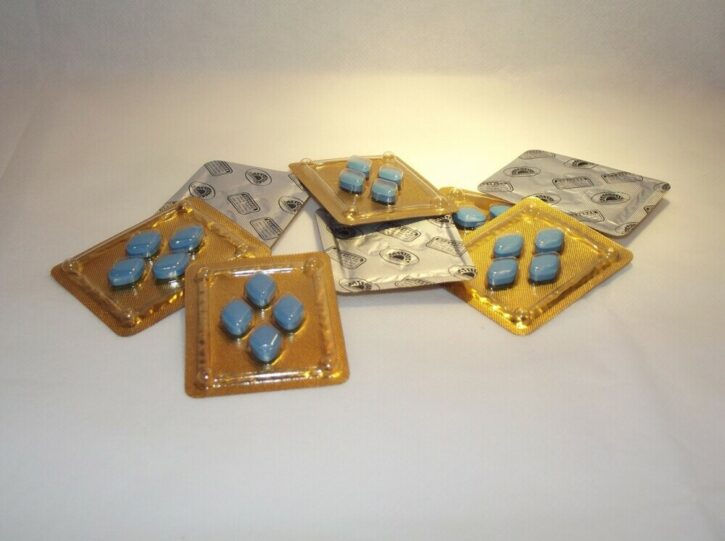


Bill Brosco
November 17, 2024After the Tyson fight many people will benefit from this article. Another informative, easy read by Sami Webb.